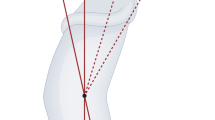Abstract
This study objective is to examine the intracavernosal pressure (ICP) in hypospadias boys with and without previous corporotomies. Retrospectively, the ICPs that were measured routinely as part of the artificial erection test in boys who underwent hypospadias repair were collected. The measurement (mmHg) included a slow manual saline instillation and a 21-gauge needle in the corpora cavernosa, which was connected to a pressure monitor. The full and rigid erections were defined according to the Erection Hardness Score by agreement between the two surgeons operating on the patient. Included were 61 boys with a median age of 15 months (IQR 8–27). Group A included 32 boys with coronal, subcoronal, or penile hypospadias. Group B included 29 boys with penoscrotal, scrotal, and perineal hypospadias. The median pressures at full erection for Groups A and B were 71.5 (IQR 59–79) and 62.5 (IQR 48–71) (p = 0.036), respectively, and at rigid erection were 283 (IQR 219-310) and 237 (IQR 182–278) (p = 0.032), respectively. In group B, median pressures at full erection for boys with and without previous corporotomies were 53.5 (IQR 45–65) and 69 (IQR 57–82), respectively (p = 0.001), and at rigid erection were 189.5 (IQR 113–263) and 264.5 (IQR 226–298), respectively (p = 0.003). In a comparison between group A boys to 18 boys in group B who did not have corporotomies, the median pressures at full erection were 71.5 (IQR 59–79) and 69 (IQR 57–82), respectively (p = 0.9), and at rigid erection were 283 (IQR 219–310) and 264 (IQR 226–298), respectively (p = 0.86). In conclusion, ICPs of artificial erections are lower in proximal hypospadias and in boys with previous corporotomies. The durability and the implications of these pressures require further research.
This is a preview of subscription content, access via your institution
Access options
Subscribe to this journal
Receive 8 print issues and online access
$259.00 per year
only $32.38 per issue
Buy this article
- Purchase on Springer Link
- Instant access to full article PDF
Prices may be subject to local taxes which are calculated during checkout



Similar content being viewed by others
Data availability
The datasets generated during and analyzed during the current study are available from the corresponding author on reasonable request.
References
Sattar AA, Salpigides G, Vanderhaeghen JJ, Schulman CC, Wespes E. Cavernous oxygen tension and smooth muscle fibers: relation and function. J Urol. 1995;154:1736–9.
Meehan JP, Goldstein AM. High pressure within corpus cavernosum in man during erection. Its probable mechanism. Urology. 1983;21:385–7. https://doi.org/10.1016/0090-4295(83)90158-9.
Snodgrass W, Bush N. Staged Tubularized Autograft Repair for Primary Proximal Hypospadias with 30-Degree or Greater Ventral Curvature. J Urol. 2017;198:680–6.
Tack LJW, Springer A, Riedl S, Tonnhofer U, Hiess M, Weninger J. et al. Adolescent and Young Adult Urogenital Outcome following Childhood Hypospadias Repair: Perfection Revisited. J Urol. 2021;206:734–44. https://doi.org/10.1097/JU.0000000000001869.
Gul M, Hildorf S, Silay MS. Sexual functions and fertility outcomes after hypospadias repair. Int J Impot Res. 2021;33:149–63. https://doi.org/10.1038/s41443-020-00377-5.
Mulhall JP, Goldstein I, Bushmakin AG, Cappelleri JC, Hvidsten K. Validation of the erection hardness score. J Sex Med. 2007;4:1626–34. https://doi.org/10.1111/j.1743-6109.2007.00600.x.
Koraitim M. Predicting risk of erectile dysfunction after pelvic fracture urethral injury in children. J Urol. 2014;192:519–23.
Ritenour CW, Seidel KD, Leisenring W, Mertens AC, Wasilewski-Masker K, Shnorhavorian M, et al. Erectile Dysfunction in Male Survivors of Childhood Cancer—A Report From the Childhood Cancer Survivor Study. J Sex Med. 2016;13:945–54.
Gamé X, Moscovici J, Gamé L, Sarramon JP, Rischmann P, Malavaud B. Evaluation of sexual function in young men with spina bifida and myelomeningocele using the International Index of Erectile Function. Urology. 2006;67:566–70. https://doi.org/10.1016/j.urology.2005.09.014.
Mulhall JP, Luo X, Zou KH, Stecher V, Galaznik A. Relationship between age and erectile dysfunction diagnosis or treatment using real-world observational data in the USA. Int J Clin Pr. 2016;70:1012–8. https://doi.org/10.1111/ijcp.12908.
Husmann DA. Erectile dysfunction in patients undergoing multiple attempts at hypospadias repair: Etiologies and concerns. J Pediatr Urol. 2021;17:166.e1–166.e7.
NA: NIH Consensus Conference. Impotence. NIH Consensus Development Panel on Impotence. JAMA. 1993;270:83–90.
Anatomy and physiology of erection: pathophysiology of erectile dysfunction. Int J Impot Res. 2003;15S5-S8. https://doi.org/10.1038/sj.ijir.3901127.
Cellek S, Cameron NE, Cotter MA, Muneer A. Pathophysiology of diabetic erectile dysfunction: potential contribution of vasa nervorum and advanced glycation endproducts. Int J Impot Res. 2013;25:1–6. https://doi.org/10.1038/ijir.2012.30.
Xu CC, Pan YN, Tang YF, Zhang J, Wang GY, Huang QL. Comprehensive assessment of cavernosography with 320-row dynamic volume CT versus conventional cavernosography in erectile dysfunction patients caused by venous leakage. Biosci Rep. 2017;37:BSR20170112. https://doi.org/10.1042/BSR20170112.
Lucas-Herald AK, Montezano AC, Alves-Lopes R, Haddow L, Alimussina M, O’Tooleet S, et al. Vascular dysfunction and increased cardiovascular risk in hypospadias. Eur Heart J. 2022;43:1832–45.
Author information
Authors and Affiliations
Contributions
DB-M: conceptualization, methodology, investigation, data curation, writing—original draft. FAS: methodology, investigation. MF: formal analysis, data curation, writing—review and editing, visualization. All authors approved the final manuscript as submitted and agree to be accountable for all aspects of the work.
Corresponding author
Ethics declarations
Competing interests
The authors declare no competing interests.
Ethical approval
IRB approval number 0267-22 RMC.
Additional information
Publisher’s note Springer Nature remains neutral with regard to jurisdictional claims in published maps and institutional affiliations.
Rights and permissions
Springer Nature or its licensor (e.g. a society or other partner) holds exclusive rights to this article under a publishing agreement with the author(s) or other rightsholder(s); author self-archiving of the accepted manuscript version of this article is solely governed by the terms of such publishing agreement and applicable law.
About this article
Cite this article
Ben-Meir, D., Abu Sbaih, F. & Frumer, M. Intracavernosal pressure of the erect penis in children with hypospadias. Int J Impot Res 36, 68–71 (2024). https://doi.org/10.1038/s41443-023-00788-0
Received:
Revised:
Accepted:
Published:
Issue Date:
DOI: https://doi.org/10.1038/s41443-023-00788-0
This article is cited by
-
Comment on: Intracavernosal pressure of the erect penis in children with hypospadias
International Journal of Impotence Research (2024)
-
Response to the Commentary on: Intracavernosal pressure of the erect penis in children with hypospadias
International Journal of Impotence Research (2024)



